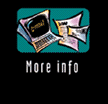

Receive a free subscription to this quarterly e-mail newsletter




1. Have enough people. A trade show isn't a vacation or a boon-doggle, it's a head-to-head selling opportunity. Make sure you have enough staff for the expected visitors.
2. Identify booth personnel. Sometimes it's hard to tell the booth tenders from the booth visitors. Identify your staff with distinctive buttons, shirts, blazers or uniforms. Nothing is more frustrating than having to look for someone to help you.
3. Practice. Spend some time with your booth personnel before the show to rehearse the sales presentation. This would also be a good time to anticipate the questions your staff might be asked...and come up with the answers.
4. Set the rules. No smoking, no eating, no drinking, no swearing. The demeanor of your booth personnel has a lot to do with the overall success of your booth.
5. Pay attention to booth design. Design your booth so it's easy to get into and out of. Make it look inviting. Plan on supplemental light - you can't count on the exhibit hall's overhead lighting to be enough to showcase your booth and products well.
6. Keep it simple. Don't get bogged down in detail. Make sure your company and brand name are clearly identified, then concentrate on just the main points of your sales story.
7. Use signage effectively. Use "shelf talkers" and other signage to put across the key benefits and features of your product. There won't always be a salesman handy, and even when there is, some people prefer to shop alone.
8. Tie booth graphics to advertising. We can never understand why a company has one theme or look going in their national advertising campaign, and something completely different going on in their booth. Unify your themes and you'll get more mileage - and memorability - from them.
9. Don't let them walk away empty-handed. It's common practice to get a prospect's name and send them literature after the show, but it's still a good idea to give them something to take along that re-emphasizes your key selling points.
10. Make it easy for buyers. Make sure prospects understand how to buy your product. Give them a listing of dealers in their area, set up a specific sales appointment for after the show, or, if allowed, arrange a sales meeting during the show.
11. Focus on the product. Getting attention is so important at many trade shows, that companies sometimes focus on their entertainment - a magician, barker, robot or scantily clad model- to the detriment of their overall sales presentation. Keep your efforts focused on selling your product.
12. Remember the trade press. Have a professionally prepared press kit available for journalists that may drop by. Better still, make the effort to specifically invite key editors to your booth, then give them access to top executives and information they can really use.
13. Target key prospects. Send an invitation to your customer and prospect list that tells them about your participation in the show and invites them to visit your booth or hospitality suite.
14. Don't go for body counts. Sure, you can have a give-away or contest in your booth to generate traffic, but really, are you getting qualified prospects that way, or just a bunch of people looking for something for nothing?
15. Analyze your performance. At the end of each day, spend a few minutes with booth personnel to compare notes and discuss any adjustments that need to be made in the sales presentation to help sell better on succeeding days.
Marketing Strategy | Advertising | Public Relations | Web Development
1124 Main Street, Ste. B, Irvine, CA 92614
ph: (949) 251-0704 | fax: (949) 251-0806 | www.rwmarketing.com
Ripley-Woodbury Info
8:30 a.m. - 5 p.m., Monday - Friday, Pacific Time
© 1997 by Ripley-Woodbury Marketing Communications, all rights reserved.